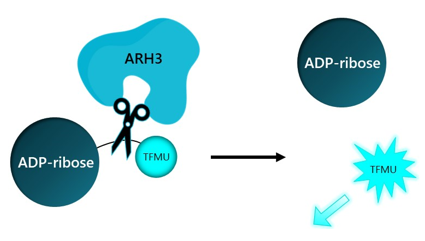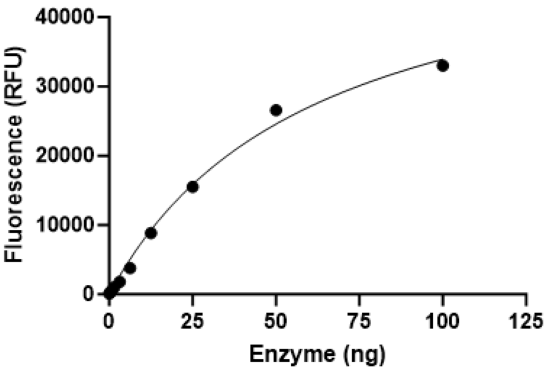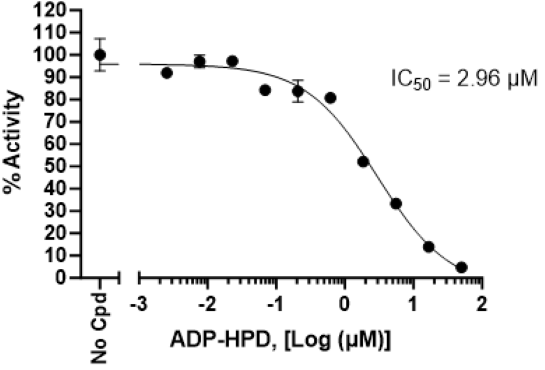ARH3 Fluorogenic Assay Kit
The ARH3 Fluorogenic Assay Kit is a high-throughput, homogeneous 96-well assay designed to measure the hydrolase activity of ARH3 (ADP-ribosylhydrolase) for screening and profiling applications, using a simple and straightforward fluorogenic assay. The ARH3 Fluorogenic Assay Kit contains enough purified recombinant ARH3 enzyme, substrate, and assay buffer for 100 enzyme reactions. The kit includes the ARH3 inhibitor ADP-HPD as an ARH3 activity control.

Figure 1: Illustration of the assay principle.
ARH3 is incubated with a fluorogenic ADP-ribose substrate in which the fluorophore is quenched by the presence of the ribose. ARH3-mediated hydrolysis of the substrate between the ribose and the fluorochrome releases fluorescence that can be detected at λ=502 nm (excitation at λ=385 nm). Fluorescence intensity is directly proportional to ARH3 hydrolase activity
Need us to run inhibitor screens or profile your compounds against ARH3? Check out our DNA Replication & Repair Screening Services.
- Fluorescence plate reader capable of excitation at λ=385 nm and detection at λ=502 nm
- Adjustable micropipettor and sterile tips
- Orbital shaker
| Catalog # | Name | Amount | Storage |
| 101852 | ARH3, His-Tag* | ≥ 1 µg | -80°C |
| Fluorogenic ARH3 Substrate (1 mM) | 25 µl | -20°C | |
| Stock ARH3 Hydrolase Buffer | 1.2 ml | -20°C | |
| 0.5 M DTT | 200 µl | -20°C | |
| ADP-HPD (1 mM) | 10 µl | -20°C | |
| 79685 | 96-well microplate, black | 1 plate | Room Temp |
*The concentration of the protein is lot-specific and will be indicated on the tube.
ARH3, also known as ADP-ribosyl-acceptor hydrolase 3 or ADPRS, is part of the DNA damage response machinery. It removes ADP-ribose from serine residues in a Mg2+ - dependent manner. It acts sequentially to PARG (poly(ADP-ribose) glycohydrolase) and it has a protective role by decreasing the levels of ADP-ribosylation in the cell, which stops mitochondria from releasing PAR-driven AIF (apoptosis inducing factor). Mutations that result in loss of function of this protein lead to CONDSIAS (stress-induced childhood-onset neurodegeneration with variable ataxia and seizures), a disease with multiple clinical expressions. Patients can accumulate mono(ADP-ribose) on core histones (scars) and have reduced levels of H3K9 acetylation. In vitro these scars were shown to if PARP was inhibited. The development and use of ARH3 inhibitors will provide us a better understanding of the DNA damage response pathway and opens new therapeutic avenues.
Rack, JGM. et al. 2018 Cell Chem Biol 25 (12): 1533-1546.
Drown, B. S. et al., 2018 Cell Chem Biol 25 (12): 1562-1570.
Liu, X. et al. 2020 J Biol Chem 295 (40): 13838-13849.
Hanzlikova H., et al., 2020 Nat Commun. 11(1):3391.



